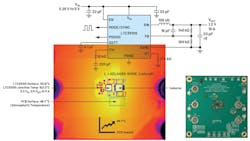Using PoL DC-DCs to Solve Voltage Accuracy, Efficiency, Latency Issues (.PDF Download)
Proximity to power. It’s one of the best ways to improve voltage accuracy, efficiency, and the dynamic response of a power rail. A point-of-load (PoL) converter is a power-supply dc-dc converter placed as close to the load as possible to achieve proximity to power.
Applications that benefit from PoL converters include high-performance CPUs, SoCs, and FPGAs—all of which require ever-increasing power levels. In automotive applications, for example, the number of sensors used for an advanced driver-assistance system (ADAS)—such as those in radar, LiDAR, and vision systems—is steadily multiplying. Thus, faster data processing (more power) is needed to detect and track surrounding objects with minimal latency.
